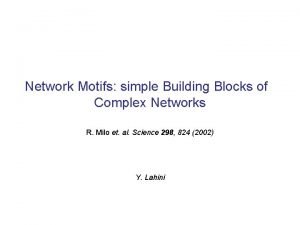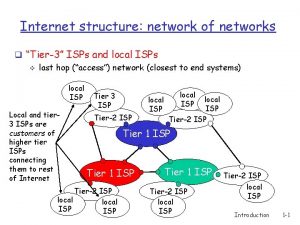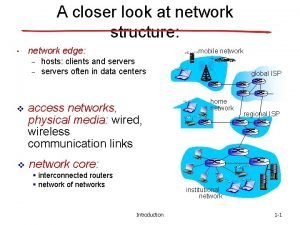Chapter 1 Hierarchical Network Design Connecting Networks PresentationID































- Slides: 31

Chapter 1: Hierarchical Network Design Connecting Networks Presentation_ID © 2008 Cisco Systems, Inc. All rights reserved. Cisco Confidential 1

Chapter 1 1. 0 Introduction 1. 1 Hierarchical Network Design Overview 1. 2 Cisco Enterprise Architecture 1. 3 Evolving Network Architectures 1. 4 Summary

1. 1 Hierarchical Network Design Overview Presentation_ID © 2008 Cisco Systems, Inc. All rights reserved. Cisco Confidential 3

Enterprise Network Campus Design Network Requirements § Small network – Provides services for 1 to 200 devices. § Medium-sized network – Provides services for 200 to 1, 000 devices. § Large network – Provides services for 1, 000+ devices.

Enterprise Network Campus Design Structured Engineering Principles houževnatost, odolnost, pružnost

Hierarchical Network Design Network Hierarchy § Access layer – Provides workgroup or user access to the network. § Distribution layer – Provides policy-based connectivity. § Core layer – Provides fast transport between distribution switches.

Hierarchical Network Design Access Layer § Layer 2 switching § High availability § Port security § Qo. S § Address Resolution Protocol (ARP) inspection § Virtual access control lists (VACLs) § Spanning tree § Power over Ethernet (Po. E) and auxiliary VLANs for Vo. IP

Hierarchical Network Design Distribution Layer § Aggregation of LAN or WAN links § Policy-based security: access control lists (ACLs) and filtering § Routing services between LANs and VLANs and between routing domains (e. g. , EIGRP to OSPF) § Redundancy and load balancing § A boundary for route aggregation and summarization configured on interfaces toward the core layer

Hierarchical Network Design Core Layer § Provides high-speed switching (i. e. , fast transport) § Provides reliability and fault tolerance § Scales by using faster, and not more, equipment § Avoids CPU-intensive packet manipulation caused by security, inspection, quality of service (Qo. S) classification, or other processes

M 4 18/1

= patro, poschodí Hierarchical Network Design Two-Tier Collapsed Core Design § A two-tier hierarchical “collapsed core” is when the distribution layer and core layer functions are implemented by a single device. § Used by smaller businesses to reduce network cost while maintaining most of the benefits of the three-tier hierarchical model.

1. 2 Cisco Enterprise Architecture Presentation_ID © 2008 Cisco Systems, Inc. All rights reserved. Cisco Confidential 12

Modular Network Design Modular Design § Modular design separates the network into various functional network modules.

Modular Network Design Modules in the Enterprise Architecture § Access-distribution module § Services module § Data center module § Enterprise Edge module § Příklad sdružování zařízení do modulů

Cisco Enterprise Architecture Model Cisco Enterprise Architecture modules: • Enterprise Campus • Enterprise Edge • Service Provider Edge

Cisco Enterprise Architecture Model Cisco Enterprise Campus A campus network is a building or group of buildings connected into one enterprise network that consists of many LANs.

Cisco Enterprise Architecture Model Cisco Enterprise Edge The enterprise edge module provides connectivity for voice, video, and data services outside the enterprise.

Cisco Enterprise Architecture Model Service Provider Edge

Cisco Enterprise Architecture Model Cisco Enterprise Data Center

Cisco Enterprise Architecture Model Cisco Enterprise Branch

Cisco Enterprise Architecture Model Cisco Enterprise Teleworker

1. 3 Evolving Network Architectures = rozvíjení, další vývoj Presentation_ID © 2008 Cisco Systems, Inc. All rights reserved. Cisco Confidential 22

Cisco Enterprise Architectures IT Challenges Some of the top trends include: § Bring Your Own Device (BYOD) § Online collaboration § Video communication § Cloud computing

Cisco Enterprise Architectures Emerging Enterprise Architectures

Emerging Network Architectures Cisco Borderless Networks

Emerging Network Architectures Collaboration Architecture Cisco’s collaboration architecture is composed of three layers: § Application and Devices – Unified communications and conference applications, such as Cisco Web. Ex Meetings, Web. Ex Social, Cisco Jabber, and Tele. Presence. § Collaboration Services – Supports collaboration applications. § Network and Computer Infrastructure – Allows collaboration anytime, from anywhere, on any device.

Emerging Network Architectures Data Center and Virtualization The data center architecture consists of three components: § Cisco Unified Management Solutions – Simplifies and automates the process of deploying IT infrastructure and services with speed and enterprise reliability. § Unified Fabric Solutions – Delivers network services to servers, storage, and applications, providing transparent convergence, and scalability. § Unified Computing Solutions – Cisco’s next-generation data center system unites computing, network, storage access, and virtualization into a cohesive system designed to reduce total cost of ownership (TCO).

1. 4 Summary Presentation_ID © 2008 Cisco Systems, Inc. All rights reserved. Cisco Confidential 28

Chapter 1: Summary § Structured engineering principles of good network design hierarchy: • modularity • resiliency = houževnatost, odolnost, pružnost • flexibility § Typical enterprise hierarchical LAN campus network design: • access layer • distribution layer • core layer § Smaller enterprise networks may use a “collapsed core” hierarchy, whereas the distribution and core layer functions are implemented in a single device. § The benefits of a hierarchical network: • scalability • redundancy • performance • ease of maintenance

Chapter 1: Summary (cont. ) § Modular design • separates the functions of a network • enables flexibility • facilitates implementation and management § Cisco Enterprise Architecture modules are used to facilitate the design of large, scalable networks. § Primary modules • Enterprise Campus • Enterprise Edge • Service Provider Edge • Enterprise Data Center • Enterprise Branch • Enterprise Teleworker

Presentation_ID © 2008 Cisco Systems, Inc. All rights reserved. Cisco Confidential 31
 Collapsed core network
Collapsed core network Design issues of network layer
Design issues of network layer Network layer design issues
Network layer design issues Jeus nodemanager
Jeus nodemanager Hierarchical task network planning
Hierarchical task network planning Virtual circuit approach
Virtual circuit approach Backbone networks in computer networks
Backbone networks in computer networks Connecting rod diagram with dimensions
Connecting rod diagram with dimensions Hierarchical physical design flow
Hierarchical physical design flow Hierarchical design in verilog
Hierarchical design in verilog Hierarchical object oriented design
Hierarchical object oriented design Ece 526
Ece 526 Palo alto networks certified network security consultant
Palo alto networks certified network security consultant Principles of network applications in computer networks
Principles of network applications in computer networks Network motifs: simple building blocks of complex networks
Network motifs: simple building blocks of complex networks Tier 3 isp
Tier 3 isp Internet structure network of networks
Internet structure network of networks Network performance measurement in computer networks
Network performance measurement in computer networks Network performance measures
Network performance measures Performance metrics in computer networks
Performance metrics in computer networks Network design in the supply chain chapter 5
Network design in the supply chain chapter 5 Neural networks for rf and microwave design
Neural networks for rf and microwave design Elementary data link protocols
Elementary data link protocols Function of the connecting rod
Function of the connecting rod Types of speciation
Types of speciation Marine ot desing
Marine ot desing What is an isoline
What is an isoline Hook background thesis order
Hook background thesis order Connecting the concepts angiosperm reproductive structures
Connecting the concepts angiosperm reproductive structures What is the connecting stalk
What is the connecting stalk Creativity is just connecting things
Creativity is just connecting things Sentences expressing cause and effect
Sentences expressing cause and effect






















































